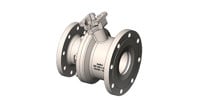Flow control for swing adsorption
Swing adsorption processes are used to separate or purify gases to produce industrial applicable products. Swing adsorption, whether it be pressure swing adsorption (PSA) or vacuum swing adsorption (VSA), is at the profit center for Industrial Gas manufacturers. The longer and more efficiently this process runs the more productive and profitable the plant will be. Interruptions in the supply of gases like hydrogen, nitrogen and oxygen are unacceptable to you, your customers, and to us.








